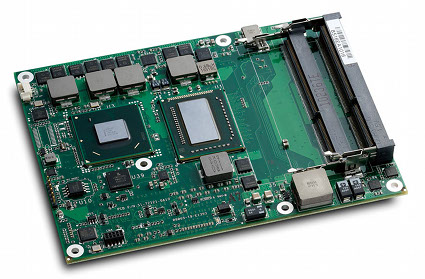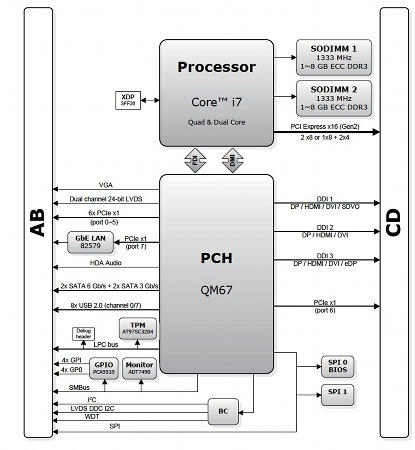Type 6 COM Express module shrugs off heat, shocks
Nov 29, 2011 — by LinuxDevices Staff — from the LinuxDevices Archive — 12 viewsAdlink announced a shock-resistant COM Express module that offers a Type 6 pinout and a choice of three different Intel Core i7 processors. The Express-HRR accepts up to 16GB of DDR3 memory, has eight USB 2.0 ports and four SATA ports, supports VGA, LVDS, and DDI (digital display interface) displays, and has multiple PCI Express expansion lanes, the company says.
Adlink's Express-HRR adopts the COM Express Basic (4.9 x 3.7 inches) form factor, along with a COM Express Type 6 pinout. (For more information on the latter — which had started cropping up on modules by January 2010, and was formally adopted as part of the COM Express Revision 2.0 spec in September of the same year — see the background information later in this story.)

Adlink's Express-HRR
(Click to enlarge)
According to Adlink, this "Ampro by Adlink"-branded module has a circuit board that's 50 percent thicker than usual, so it can withstand shocks of up to 50G (11ms duration). An extended-temperature version (-40 to 185 deg. F) is available too, the company says.
Buyers can choose one of three different Intel "Sandy Bridge" processors, says Adlink. These are:
- the Core i7-2715QE (2.1GHz clock speed, 3GHz TurboBoost frequency, four cores, 6MB of cache, 45-Watt TDP)
- the Core i7-2655LE (2.2GHz clock speed, 2.9GHz TurboBoost frequency, two cores, 4MB of cache, 25-Watt TDP)
- the Core i7-2610UE (1.5GHz clock speed, 2.4GHz TurboBoost frequency, two cores, 4MB of cache, 17-Watt TDP)
Each of these processors is accompanied here by Intel's QM67 Express chipset (block diagram), which permits devices to offer two 6Gbps SATA ports and four 3Gbps SATA ports. The Express-HRR limits itself to two 6Gbps ports and two 3Gbps ports (with RAID support), also including eight USB 2.0 ports, according to Adlink.
Capable of accepting up to 16GB of DDR3 memory via its two SODIMM slots, the Express-HRR has a gigabit Ethernet port. Adlink says the module can support VGA, LVDS, and DDI (SDVO, DisplayPort, HDMI, or DVI) displays, though there's no word on how many of these video outputs can be used simultaneously.

A block diagram of Adlink's Express-HRR
(Click to enlarge)
The Express-HRR also has a PCI Express x16 interface that can be used to connect a GPU (graphics processing unit), or configured for general-purpose x8/4/1 expansion, according to Adlink. It further includes seven PCI Express x1 lanes, the company adds.
According to Adlink, the module provides LPC, SMBus, and I2C interfaces. There's also an Atmel AT97SC3204 trusted platform module, says the company.
Specifications listed for the Express-HRR by Adlink include:
- Processor:
- Core i7-2715QE (2.1GHz clock speed, 3GHz TurboBoost frequency, four cores, 6MB of cache, 45-Watt TDP)
- Core i7-2655LE (2.2GHz clock speed, 2.9GHz TurboBoost frequency, two cores, 4MB of cache, 25-Watt TDP)
- Core i7-2610UE (1.5GHz clock speed, 2.4GHz TurboBoost frequency, two cores, 4MB of cache, 17-Watt TDP)
- Chipset — Intel QM67 Express
- Memory — up to 16GB of DDR3 RAM via two SODIMM slots
- Storage — 2 x 3.0Gbps SATA ports, 2 x 6.0Gbps SATA ports
- Expansion:
- 1 x PCI Express x16 (may also be configured to offer x8/4/1 expansion)
- 7 x PCI Express x1
- Networking — gigabit Ethernet
- Other I/O:
- VGA
- LVDS
- DDI (SDVO, DisplayPort, HDMI, DVI)
- 8 x USB 2.0
- I2C
- LPC
- SMBus
- Power requirements — "tbd"
- Operating range — 32 to 158 deg. F in standard version; -40 to 185 deg. F in extended-temp version (n/a for Core i7-2715QE)
- Dimensions — 4.9 x 3.7 inches
More about pinouts
The COM Express Type 1 pinout features one 220-pin connector — the A-B connector — and supports up to eight USB 2.0 ports, up to four SATA or SAS ports, and up to six PCI Express Gen1/Gen2 lanes. It supports dual 24-bit LVDS, an HD audio interface, gigabit Ethernet, plus eight GPIO pins and SPI.
COM Express Type 2, also a common visitor to LinuxDevices, has all the above functionality, but adds a second 220-pin connector (C-D). This allows a 32-bit PCI interface plus IDE ports to support legacy PATA devices such as PATA HDD, and CompactFlash memory cards. There are a total of 22 PCI Express lanes (six on the A-B connector and up to 16 on the C-D connector), 16 lanes on the second connector being intended for PCI Express Graphics (PEG).
In September 2011, the PCI Industrial Computer Manufacturers Group (PICMG) adopted the COM Express revision 2.0 spec, ratifying the 3.75 x 3.75 inch COM Express Compact Module size and adding Digital Display Interfaces (DDIs). It also approved new Type 6 and Type 10 pinouts.
Type 6 addresses the need for digital display and USB 3.0 interfaces and offers a simple upgrade path for existing Type 2-based designs. The Type 6 pinout can support up to three DDIs, including SDVO, DisplayPort, and HDMI/DVI. It also adds support for USB 3.0 and two additional PCI Express Lanes, for a total of 23.
Type 10, a single-connector pinout similar to Type 1, retains a 220-pin connector but no longer reserves pins for SATA 2 and SATA 3. These pins can now be used for new technologies such as USB 3.0.
Similarly, Type 10 no longer reserves pins for PCI Express lanes 4 and 5. In addition, it uses the second LVDS channel, previously employed for VGA, to support SDVO, DisplayPort, or HDMI/DVI.
Further information
According to Adlink, the Express-HRR supports Linux, Windows 7, Windows XP, Windows XP Embedded, Windows CE 6.0, QNX, and VxWorks. More information on the module, which appears to be available now, may be found on the Express-HRR product page.
Jonathan Angel can be reached at [email protected] and followed at www.twitter.com/gadgetsense.
This article was originally published on LinuxDevices.com and has been donated to the open source community by QuinStreet Inc. Please visit LinuxToday.com for up-to-date news and articles about Linux and open source.